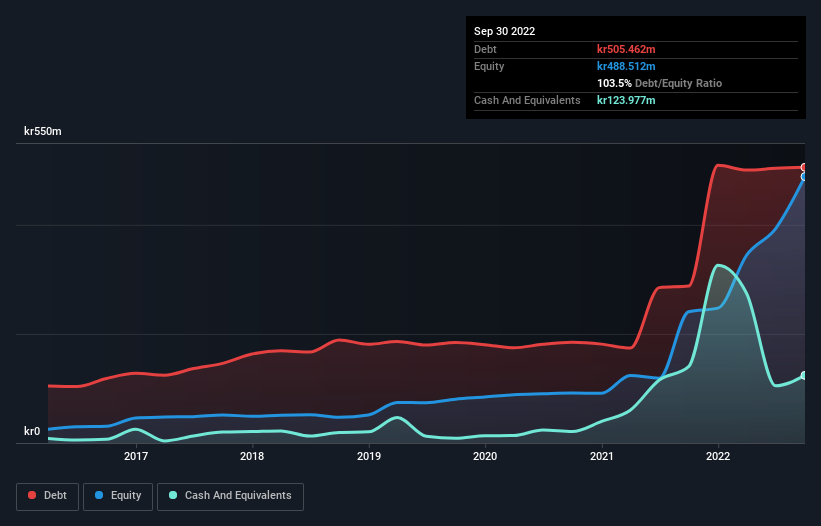
Legendary fund manager Li Lu (who Charlie Munger backed) once said, 'The biggest investment risk is not the volatility of prices, but whether you will suffer a permanent loss of capital.' It's only natural to consider a company's balance sheet when you examine how risky it is, since debt is often involved when a business collapses. We can see that ADDvise Group AB (publ) (STO:ADDV A) does use debt in its business. But should shareholders be worried about its use of debt?
When Is Debt A Problem?
Generally speaking, debt only becomes a real problem when a company can't easily pay it off, either by raising capital or with its own cash flow. In the worst case scenario, a company can go bankrupt if it cannot pay its creditors. However, a more common (but still painful) scenario is that it has to raise new equity capital at a low price, thus permanently diluting shareholders. Of course, plenty of companies use debt to fund growth, without any negative consequences. The first step when considering a company's debt levels is to consider its cash and debt together.
Check out our latest analysis for ADDvise Group
How Much Debt Does ADDvise Group Carry?
As you can see below, at the end of September 2022, ADDvise Group had kr505.5m of debt, up from kr287.7m a year ago. Click the image for more detail. However, because it has a cash reserve of kr124.0m, its net debt is less, at about kr381.5m.

How Healthy Is ADDvise Group's Balance Sheet?
The latest balance sheet data shows that ADDvise Group had liabilities of kr293.3m due within a year, and liabilities of kr732.7m falling due after that. Offsetting this, it had kr124.0m in cash and kr250.3m in receivables that were due within 12 months. So its liabilities outweigh the sum of its cash and (near-term) receivables by kr651.8m.
ADDvise Group has a market capitalization of kr1.46b, so it could very likely raise cash to ameliorate its balance sheet, if the need arose. However, it is still worthwhile taking a close look at its ability to pay off debt.
We measure a company's debt load relative to its earnings power by looking at its net debt divided by its earnings before interest, tax, depreciation, and amortization (EBITDA) and by calculating how easily its earnings before interest and tax (EBIT) cover its interest expense (interest cover). Thus we consider debt relative to earnings both with and without depreciation and amortization expenses.
With net debt to EBITDA of 3.7 ADDvise Group has a fairly noticeable amount of debt. On the plus side, its EBIT was 9.5 times its interest expense, and its net debt to EBITDA, was quite high, at 3.7. Notably, ADDvise Group's EBIT launched higher than Elon Musk, gaining a whopping 123% on last year. The balance sheet is clearly the area to focus on when you are analysing debt. But it is future earnings, more than anything, that will determine ADDvise Group's ability to maintain a healthy balance sheet going forward. So if you want to see what the professionals think, you might find this free report on analyst profit forecasts to be interesting.
Finally, a business needs free cash flow to pay off debt; accounting profits just don't cut it. So the logical step is to look at the proportion of that EBIT that is matched by actual free cash flow. During the last three years, ADDvise Group burned a lot of cash. While investors are no doubt expecting a reversal of that situation in due course, it clearly does mean its use of debt is more risky.
Our View
ADDvise Group's conversion of EBIT to free cash flow was a real negative on this analysis, although the other factors we considered were considerably better. There's no doubt that its ability to to grow its EBIT is pretty flash. We would also note that Medical Equipment industry companies like ADDvise Group commonly do use debt without problems. When we consider all the factors mentioned above, we do feel a bit cautious about ADDvise Group's use of debt. While debt does have its upside in higher potential returns, we think shareholders should definitely consider how debt levels might make the stock more risky. The balance sheet is clearly the area to focus on when you are analysing debt. But ultimately, every company can contain risks that exist outside of the balance sheet. For example ADDvise Group has 4 warning signs (and 2 which don't sit too well with us) we think you should know about.
Of course, if you're the type of investor who prefers buying stocks without the burden of debt, then don't hesitate to discover our exclusive list of net cash growth stocks, today.
New: Manage All Your Stock Portfolios in One Place
We've created the ultimate portfolio companion for stock investors, and it's free.
• Connect an unlimited number of Portfolios and see your total in one currency
• Be alerted to new Warning Signs or Risks via email or mobile
• Track the Fair Value of your stocks
Have feedback on this article? Concerned about the content? Get in touch with us directly. Alternatively, email editorial-team (at) simplywallst.com.
This article by Simply Wall St is general in nature. We provide commentary based on historical data and analyst forecasts only using an unbiased methodology and our articles are not intended to be financial advice. It does not constitute a recommendation to buy or sell any stock, and does not take account of your objectives, or your financial situation. We aim to bring you long-term focused analysis driven by fundamental data. Note that our analysis may not factor in the latest price-sensitive company announcements or qualitative material. Simply Wall St has no position in any stocks mentioned.
About OM:ADDV A
ADDvise Group
Supplies equipment to healthcare and research facilities in private and public sectors in Sweden, rest of Europe, North America, South America, Asia, and internationally.
Undervalued slight.
Market Insights
Community Narratives



